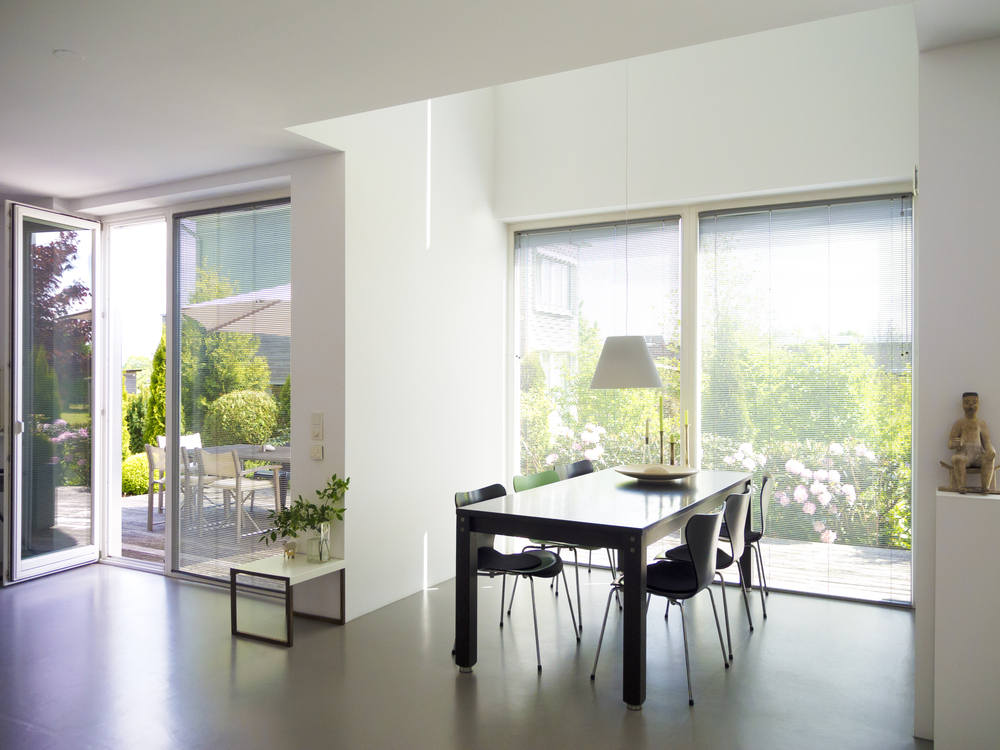What Makes Windows and Doors Energy-Efficient?

We’ve all heard of ENERGY STAR® and know that energy-efficient windows save on heating and cooling costs. But do you know how your choice of options affects a window’s energy efficiency? Below we’ll go over the elements that make windows and doors energy efficient:
Frame & Sash Materials
There are various framing materials like vinyl and wood. However, the material that provides the best energy efficiency benefits is vinyl. Vinyl windows have low-maintenance vinyl frames, and the way they are constructed helps the overall window provide excellent thermal insulation. But remember, not all vinyl is equal – thicker vinyl walls with multiple air chambers improve thermal performance.
Weather Stripping
Weatherstripping is another element that adds to energy efficiency by protecting against air leakage. The lower the air leakage, the better the energy efficiency! The average vinyl window has an air leakage rating of .3 cubic feet per minute (cfm).
Low-E Glass
Low-E refers to a special coating applied to a pane of glass. By reflecting infrared light, Low-E helps stop temperature transference. In addition to its energy-saving properties, Low-E glass helps reflect UV rays that lead to fading color on interior furnishings.
Multiple Panes of Glass
The glass itself is a terrible insulator. Older windows with only one pane of glass allowed heated or cooled air to escape more rapidly. Two panes of glass insulate much better than a single pane because of the air space between the two panes. Triple pane adds another air pocket, enhancing the insulation value even more. Adding gas between the panes improves energy efficiency dramatically!
Gas Fills
The air, between the glass panes, works as an insulator because air is a poor conductor of heat. The energy-efficient windows from Select Home Improvements go one step further and have argon gas injected between the panes of glass. Wholly transparent to the eye, these gasses are heavier than air and provide even better insulation! In the case of seal failure causing leakage, both argon and krypton are odorless, transparent, and non-toxic, so there is no need to worry!
Spacers
The spacer system offers insulation to the edges of the glass, the areas that are most vulnerable to temperature transference. They also help keep the window’s glass at the correct distance apart.
How is Energy Efficiency Measured?
Energy efficiency is measured using several different factors, such as:
- U-factor: measures how much heat is conducted through a window. This rating may apply to the whole window fixture (glass, frame, spacers, etc.) or only to the glass itself. A low U-factor signifies that a window is well-insulated and, therefore, more energy-efficient. A rating of 0.30 or below is considered very good.
- Solar heat-gain coefficient (SHGC): the fraction of solar heat energy that passes through a window. SHGC can improve indoor climate control through the installation of high-SHGC (>0.55) windows in cold climates and low-SHGC (<0.40) windows in warm climates.
- Visible transmittance (VT): the amount of visible light that can pass through a window. VT is measured on a scale of 0 to 1, where 0 signifies no light transmittance and 1 is complete light transmittance. High VT can reduce the need for artificial lighting inside a home. Coatings, glazes, and tints can reduce VT—unless they are spectrally selective (meaning they screen out certain wavelengths of solar radiation, mainly infrared, while allowing most visible light to pass through).
- Light-to-solar gain (LSG): ratio of VT to SHGC. A high LSG rating is given to a window that lets through a lot of light relative to the amount of heat.
- Low-emissivity (low-e) glazes: transparent metal-oxide insulators that block longer wavelengths of energy while still allowing visible light (shorter wavelengths) to pass through. Low-e windows work well for keeping heat either inside or outside of a building, depending on climate. In fact, adding a low-e coating to a window adds as much extra insulation as an extra pane of glass! Glazes may also help avoid condensation on the inside of windows, as well as fading of fabric, paper, or wood furnishings. They are added to one of the two inter-pane surfaces, depending on climate and manufacturer.
- Air leakage: low air leakage is always good. Windows should have a leakage rating of less than 0.30 cubic feet per minute per square foot of window and should be properly installed to avoid leaks around the edges. Windows that open outward, like awnings or casements, close more tightly than sliding windows.
Windows and doors play a significant role in how comfortable and energy-efficient your home is. If it’s time to replace the doors and windows of your home, you should invest in energy efficiency! We hope this blog helps you see what makes windows and doors energy efficient. To get high-quality, energy-efficient windows for your home, give Select Home Improvements a call at (855) 995-2233 or click here for a free quote!
Select Home Improvements is the best choice is you are looking for a window replacement contractor. If you have questions about your project please contact Select Home Improvements. We are here to assist you.
Call us at (855) 995-2233.

